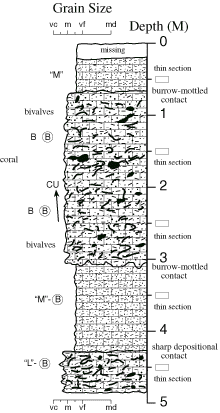|
Vibracore 30V1, north coast
Massive-appearing (bioturbated?), very fine to medium-grained, foraminiferal/algal/coral carbonate sand: pale yellowish brown (10YR6/2); moderately well sorted; composed mainly of a mix of foraminifera (29.0%), calcareous algae (21.0%), and coral fragments (20.5%); common volcanic rock fragments (6.5%) and Halimeda (7.0%). Upward coarsening succession of burrowed to bioturbated, fine to very coarse-grained, algal/coral/foraminifera carbonate sand: massive appearing owing to extensive bioturbation; olive gray (5Y6/1-4/1) to grayish orange (10YR7/4) ; very poorly sorted; abundant large (1.5-2.5 cm), disarticulated and fragmented pecten bivalves (Chlamys sp.) and coral fragments; sand size clasts angular to rounded; composed mainly of a mix of calcareous algae (29.5-46.0%), coral fragments (20.5-25.0%) and foraminifera (13.5-14.0%); common carbonate rock fragments (6.0-11.0%) and volcanic rock fragments (2.0-9.5%); minor echinoid fragments (2.0%), mollusks (1.5-5.0%), Halimeda (0.5-3.5%) and calcareous sponge spicules (1.5-4.5%). Massive-appearing (bioturbated?), fine to medium-grained, algal/coral/foraminiferal carbonate sand: pale yellowish brown (10YR6/2); moderately well sorted; composed mainly of a mix of calcareous algae (28.0%), coral fragments (22.5%) and foraminifera (20.5%); common volcanic rock fragments (8.0%) and Halimeda (6.5%). Vaguely-laminated to bioturbated, medium- to coarse-grained, foraminiferal/algal/coral carbonate sand: pale yellowish brown (10YR6/2); very poorly sorted; composed mainly of a mix of foraminifera (27.5%), calcareous algae (34.0%) and coral fragments (16.0%); common carbonate rock fragments (13.0%).
|




